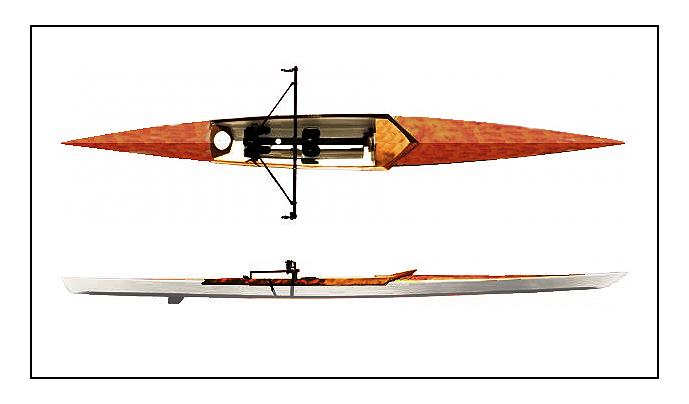I’ve been reading the instructions over and over to internalize many of the steps. Along the way, I’ve been taking note of the tools and supplies that I will and may need (in addition to the epoxy which should arrive tomorrow). Herewith:
Marine varnish (Interlux Y96 Schooner varnish, at least a quart, for the deck). But see below!
A durable and familiar epoxy paint for the hull. I used Pettit one-part EasyPoxy on the kayak and it’s held up for years. So probably that or something very much like it (white for the sides and grey for the bottom?).
Wood screws. Two 1-1/2 inch screws to attach the deck spar and many more #6, 3-4 inch, flat-head, brass ones to attach the deck to the sheer clamps. (The instructions say I should nail the deck to the sheer clamps. I say, I don’t think so. I am hopeless with a hammer, but I can usually drive a screw without actually hurting anyone.) I struck through the bit that was supplied with the kit and has been miraculously found.
Consider whether I want to stain any parts of the build. If so, that needs to be done prior to applying epoxy, of course. So if I do, then that needs to be done soon. I could stain the bulkheads, the center of the hull interior, the splashguard, and maybe the deck “inside” the splashguard’s “v”. But probably I don’t want to do that. The office will take a lot of abuse, and I’ll need to be able to clean and refresh it without “refinishing” it as if were furniture. So probably stick with the scheme shown at the top of the “Building the Boat” page (and reprised just below): white paint on the floor and sides, natural color (epoxy and varnish) on the bulkheads, the exposed sheer clamps, and the entire deck. You’ll need to sand down to epoxy to install mounting plates for the row wing by and by, but that’s easy-ish and a white interior can be retouched easily. Beware that the circular hatch(es) may be hard to locate, so stay flexible on that score. (Two days later: I was straightening up the shelves around the project and found that I’d already bought two deck plates. They’re black, contra the picture below, but they’ll do fine. I even found the screws to attach them to the bulkheads. I’ll still need bedding caulk.)

For the toolkit, I’m going to need a block plane to profile the sheer clamps, and a small handsaw to join the sheer clamps at the ends as well as to trim the deck where it will inevitably overhang the hull. The first time I started this project, I bought a neat Japanese hand saw on CLC’s recommendation, but my right arm just is not wired to operate it. Why take a chance? I also bought a small plane which turned out to be tiny and maybe suited to building a doll house. Dang. Later that same day: I found a small electric planer and a compact, fine-finish handsaw that cuts the way a handsaw is supposed to cut. I figure that the former takes less skill than a similarly priced “craftsman’s” plane, and the latter was not much more than peanuts, so… $65 to the ledger.
The next day…
That “small” electric planer is a substantial tool. Heavier and larger than I expected, but with a solid feel, and I bet it’s going to be just the ticket. I’m going to need to assault some wood with it before putting it to work on wood that matters.
I found two pints of still-sealed, well-stored Interlux Schooner Gold marine varnish. That’s a considerable savings if it’s still good. CLC forum users quoting Interlux say it should be, and one builder who used some 8 years old had no problem with it. How about 12? Try it on a small piece of wood and be sure it dries hard and in a reasonable period of time. It ought to at least be good for first coats even if I’ll need a pint of regular Schooner to overcoat it. Opinion is divided about whether it needs to be thinned a bit. Also the builders forum members are of two minds whether I should glass the deck. The plans and the designer say no, and I would rather not. It can always be done later if needed, but it cannot be undone.
I located the MAS measuring dispensers, micro-balloons and wood-filler from the first cut at the boat. (Now be sure you have all the glass; it was marked “backordered” according to the receipt I just found.) A box of foam brushes which I intended for epoxy work are waiting patiently. The day after all that: yes! All the back-ordered pieces are here, found, and stacked where they belong on the boatyard shelves.
I’m going to need more mixing cups (no, there are many, many upstairs left over from Halloween parties) and stirrers, and probably one premium brush unless the one I just found is better than I think it is. I located some plastic from which to make fillet tools (lots of wood around for that, too). And I found a ton of plastic film. Along with cups and sticks, my shopping cart contains nitrile gloves, denatured alcohol, and some pastry bags (to apply thickened epoxy). Eventually, I’ll need sanding pads (“Scotch” pads) for roughing up varnish layers. And whatever it takes to clean up brushes. I’d like to do some really minor epoxy work soon in order to tune my sensibilities and be better informed about all this. (It’s amazing how actually preparing to pour epoxy focuses the mind, especially on things that ought to be done first.)